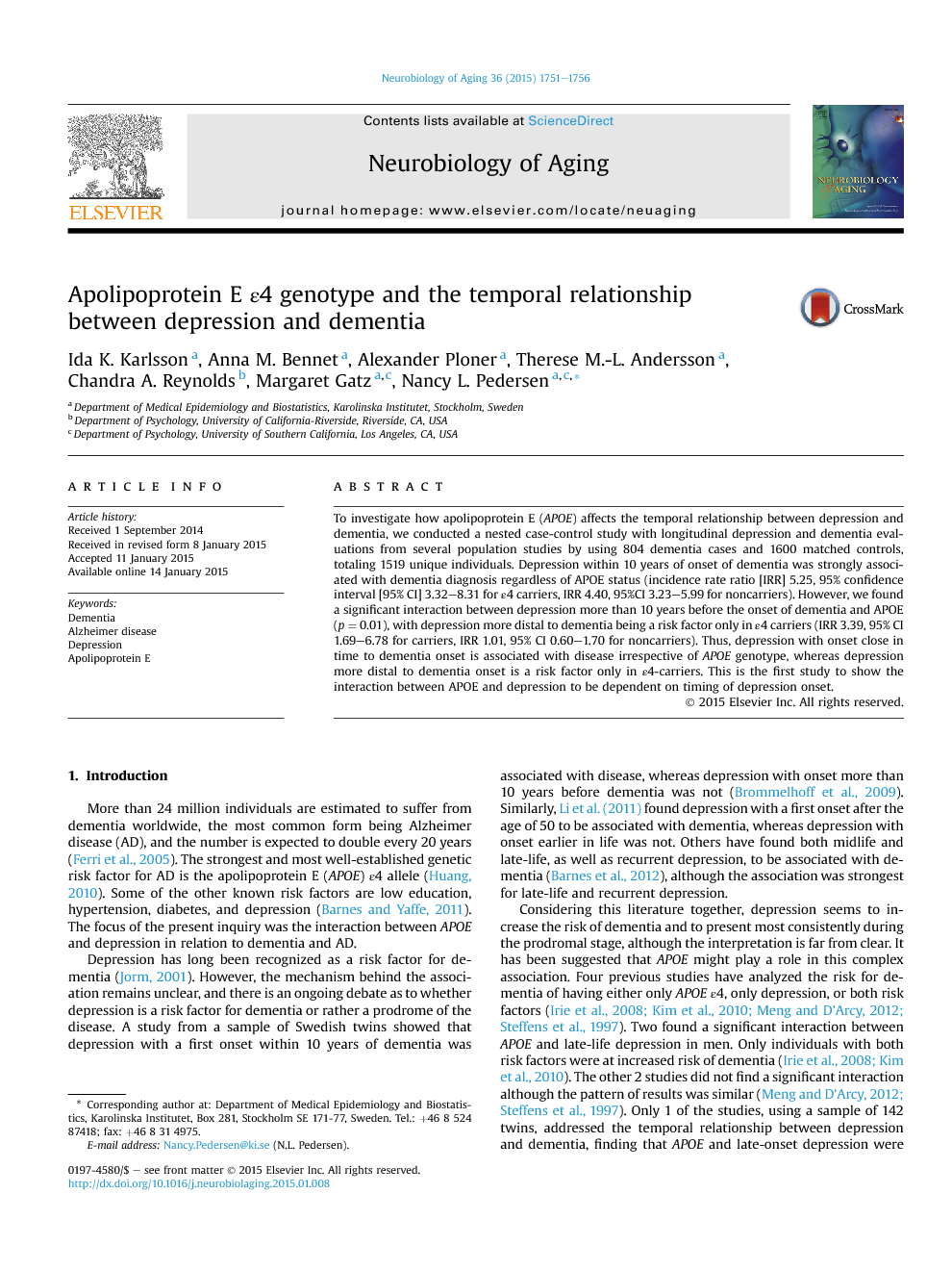To investigate how apolipoprotein E (APOE) affects the temporal relationship between depression and dementia, we conducted a nested case-control study with longitudinal depression and dementia evaluations from several population studies by using 804 dementia cases and 1600 matched controls, totaling 1519 unique individuals. Depression within 10 years of onset of dementia was strongly associated with dementia diagnosis regardless of APOE status (incidence rate ratio [IRR] 5.25, 95% confidence interval [95% CI] 3.32–8.31 for ε4 carriers, IRR 4.40, 95%CI 3.23–5.99 for noncarriers). However, we found a significant interaction between depression more than 10 years before the onset of dementia and APOE (p = 0.01), with depression more distal to dementia being a risk factor only in ε4 carriers (IRR 3.39, 95% CI 1.69–6.78 for carriers, IRR 1.01, 95% CI 0.60–1.70 for noncarriers). Thus, depression with onset close in time to dementia onset is associated with disease irrespective of APOE genotype, whereas depression more distal to dementia onset is a risk factor only in ε4-carriers. This is the first study to show the interaction between APOE and depression to be dependent on timing of depression onset.
More than 24 million individuals are estimated to suffer from dementia worldwide, the most common form being Alzheimer disease (AD), and the number is expected to double every 20 years (Ferri et al., 2005). The strongest and most well-established genetic risk factor for AD is the apolipoprotein E (APOE) ε4 allele ( Huang, 2010). Some of the other known risk factors are low education, hypertension, diabetes, and depression ( Barnes and Yaffe, 2011). The focus of the present inquiry was the interaction between APOE and depression in relation to dementia and AD.
Depression has long been recognized as a risk factor for dementia (Jorm, 2001). However, the mechanism behind the association remains unclear, and there is an ongoing debate as to whether depression is a risk factor for dementia or rather a prodrome of the disease. A study from a sample of Swedish twins showed that depression with a first onset within 10 years of dementia was associated with disease, whereas depression with onset more than 10 years before dementia was not (Brommelhoff et al., 2009). Similarly, Li et al. (2011) found depression with a first onset after the age of 50 to be associated with dementia, whereas depression with onset earlier in life was not. Others have found both midlife and late-life, as well as recurrent depression, to be associated with dementia (Barnes et al., 2012), although the association was strongest for late-life and recurrent depression.
Considering this literature together, depression seems to increase the risk of dementia and to present most consistently during the prodromal stage, although the interpretation is far from clear. It has been suggested that APOE might play a role in this complex association. Four previous studies have analyzed the risk for dementia of having either only APOE ε4, only depression, or both risk factors ( Irie et al., 2008, Kim et al., 2010, Meng and D'Arcy, 2012 and Steffens et al., 1997). Two found a significant interaction between APOE and late-life depression in men. Only individuals with both risk factors were at increased risk of dementia ( Irie et al., 2008 and Kim et al., 2010). The other 2 studies did not find a significant interaction although the pattern of results was similar ( Meng and D'Arcy, 2012 and Steffens et al., 1997). Only 1 of the studies, using a sample of 142 twins, addressed the temporal relationship between depression and dementia, finding that APOE and late-onset depression were independent risk factors for AD and that the association between depression and dementia was stronger when depression onset was closer in time to dementia ( Steffens et al., 1997).
In the present study, we investigate the association between depression and dementia and how this association is affected by the presence of APOE ε4, while considering differences between depression in the preclinical phase of dementia versus more distal to dementia onset, and depression with its onset in mid-versus late-life.
Of the 804 dementia cases, 469 had the differential diagnosis of AD. Among the 1519 unique individuals included in the study, 424 met the criteria for depression at some point. Of these, 332 were categorized as having had their first identified depression within 10 years of dementia development and 92 as having had depression more than 10 years before dementia. A total of 388 individuals were categorized as having had late-life depression, and 36 as having had midlife depression. A total of 520 individuals were carriers of the ε4 allele and 996 were noncarriers. Dementia and AD cases were significantly more likely to have low education, to have met criteria for depression, and to be carriers of the APOE ε4 allele ( Table 1).


